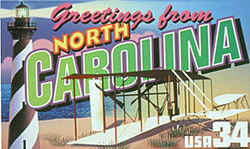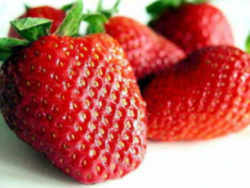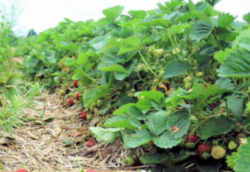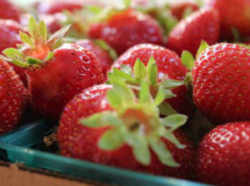
North Carolina Symbols
North Carolina State Red Berry
Strawberry

(Genus Fragaria)
Adopted in 2001.
In 2001, the General Assembly named the strawberry, (Genus Fragaria,) as the official Red Berry of North Carolina, and named the blueberry as the official Blue Berry of the state (Session laws, 2001, c. 488).
Strawberries (genus fragaria) are high in Vitamin C and A, and supply 8% of the RDA for Iron. There are only 60 calories in a cup of fresh berries and zero grams of fat. A cup of blueberries (genus vaccinium) supplies 50% of the RDA for Vitamin C, as well as 22% of the fiber recommended for a healthy diet.
The session law itself explains how important these two berries are to the agricultural economy of the state. In the year 2000, strawberries brought in over $17,000,000, while the blueberry created over $18,000,000 in revenues. According to the 1997 Census of Agriculture, North Carolina was ranked 8th in the nation for strawberries harvested, and ranked behind only 4 states in the production of blueberries.
Both berries are grown throughout the state, and consumers can pick their own berries at farms from one end of the North Carolina to the other.
North Carolina Red Berry: Strawberry

The garden strawberry (or simply strawberry Fragaria ?ananassa) is a widely grown hybrid species of the genus Fragaria (collectively known as the strawberries). It is cultivated worldwide for its fruit. The fruit (which is not a botanical berry, but an aggregate accessory fruit) is widely appreciated for its characteristic aroma, bright red color, juicy texture, and sweetness. It is consumed in large quantities, either fresh or in such prepared foods as preserves, fruit juice, pies, ice creams, milkshakes, and chocolates. Artificial strawberry aroma is also widely used in many industrial food products.
The garden strawberry was first bred in Brittany, France, in the 1750s via a cross of Fragaria virginiana from eastern North America and Fragaria chiloensis, which was brought from Chile by Am??-Fran?is Fr?ier in 1714. Cultivars of Fragaria ?ananassa have replaced, in commercial production, the woodland strawberry (Fragaria vesca), which was the first strawberry species cultivated in the early 17th century.
Technically, the strawberry is an aggregate accessory fruit, meaning that the fleshy part is derived not from the plant's ovaries but from the receptacle that holds the ovaries. Each apparent "seed" (achene) on the outside of the fruit is actually one of the ovaries of the flower, with a seed inside it.
History of the Strawberry

Wild strawberries have been growing in Italy since 235 BC. It is unknown when they started growing in North America, but when European settlers landed in Virginia in 1588, they discovered strawberries growing. Massachusetts settlers ate strawberries grown by American Indians as early as 1643.
In 1714, a French naval officer found a flowering strawberry plant in Chile. The plant was sent to a French horticulture center where the plant crossed with a North American strawberry plant. The result was a much larger berry than those grown elsewhere. Today's berries can be traced back to these plants.
Strawberries spread to California, and by the early 1900's were being grown on a large scale. Today, over 30,000 acres are planted in California each year which results in around one billion pounds of strawberries each year. Overall, California provides 80% of all the strawberries grown in the United States.
Act Adopting The Official Fruit and Berries of North Carolina.
PART I. NORTH CAROLINA'S HERITAGE OF FARMING
Whereas, North Carolina's economy originated and developed as an agrarian economy with a cornucopia of fruits and vegetables; and
Whereas, the State takes great pride in its rich heritage of farming; and
Whereas, there are still many families who base their livelihood in farming and who are continuing the North Carolina tradition of producing goods
from our land; and
Whereas, one of the main sources of agricultural production in the State is the production of fruits and berries of several varieties; and
PART II. THE SCUPPERNONG GRAPE.
Whereas, North Carolina is the home of our nation's first cultivated grape, the Scuppernong; and
Whereas, the Scuppernong grape was named after the Scuppernong River in North Carolina; and
Whereas, British explorers in 1584 and 1585 reported to Queen Elizabeth and Sir Walter Raleigh that the barrier islands of what is now, in part, Roanoke
Island were full of grapes and that the soil of the land was "so abounding with sweet trees that bring rich and most pleasant gummes, grapes of
such greatness, yet wild, as France, Spain, nor Italy hath not greater..."; and
Whereas, Sir Walter Raleigh's colony discovered the famous Scuppernong "Mother Vineyard" on Roanoke Island, a vine that is now over 400 years
old and has a trunk over two feet thick; and
Whereas, the State toast, penned in 1904, references North Carolina as the land "[w]here the scuppernong perfumes the breeze at night,";
and
PART III. THE STRAWBERRY AND THE BLUEBERRY.
Whereas, there are over 1,700 acres of strawberries and over 3,600 acres of blueberries harvested in North Carolina each year; and
Whereas, in 2000, strawberry growers in the State produced 23,000,000 pounds of strawberries, yielding $17,325,000 in revenues; and
Whereas, in 2000, blueberry growers in the State produced 17,500,000 pounds of blueberries, resulting in an increase in the State's economy of over
$18,000,000 in revenues; and
Whereas, these delicious berries are a good source of vitamins, a number of life sustaining minerals, and dietary fiber;
Whereas, the blueberry is an antioxidant, which has been proven to reduce cholesterol and lower the risk of heart disease; and
Whereas, each year the Town of Chadbourn in Columbus County hosts the North Carolina Strawberry Festival, which is one of the most celebrated traditions
in the State; and
Whereas, the State of North Carolina does not have an official fruit nor an official berry; Now, therefore,
The General Assembly of North Carolina enacts:
SECTION 1. Chapter 145 of the General Statutes is amended by adding a new section to read:
"§145-18. State fruit and State berries.
(a) The official fruit of the State of North Carolina is the Scuppernong grape (Vitis genus).
(b) The official red berry of the State is the strawberry (Fragaria genus).
(c) The official blue berry of the State is the blueberry (Vaccinium genus)."
SECTION 2. This act is effective when it becomes law.
In the General Assembly read three times and ratified this the 5th day of December, 2001.
s/ Beverly E. Perdue
President of the Senate
s/ James B. Black
Speaker of the House of Representatives
s/ Michael F. Easley
Governor
Approved 6:58 p.m. this 16th day of December, 2001
North Carolina Law
The law designating the strawberry as the official North Carolina state red berry is found in the North Carolina General Statutes, Chapter 145 Section 145-18
Chapter 145 - State Symbols and Other Official Adoptions.
Section 145-18.
§ 145-18. State fruit and State berries.
(a) The official fruit of the State of North Carolina is the Scuppernong grape (Vitis genus).
(b) The official red berry of the State is the strawberry (Fragaria genus).
(c) The official blue berry of the State is the blueberry (Vaccinium genus).
(2001-488, s. 1.)
Taxonomic Hierarchy: Strawberry
Kingdom: Plantae - Plants
Subkingdom: Tracheobionta - Vascular plants
Superdivision: Spermatophyta - Seed plants
Division: Magnoliophyta - Flowering plants
Class: Magnoliopsida - Dicotyledons
Subclass: Rosidae
Order: Rosales
Family: Rosaceae - Rose family
Genus: Fragaria L. - strawberry

List Official US State Foods






